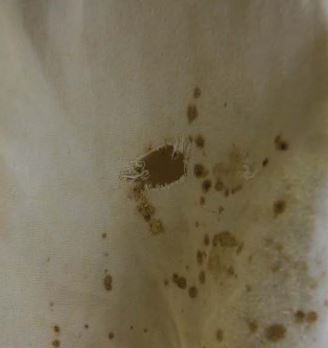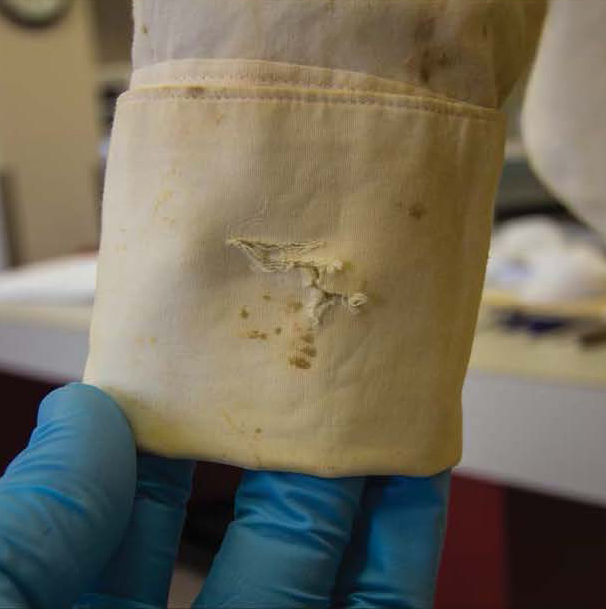Did they? If so, where is the data? SPersonivan does not even acknowledge the change, let alone provide an explanation for it.
It should not be done by anyone who has already formed a firm conclusion about what the result should be.
Where is the data of some ballistic expert showing that Larry SPersonivan's most recent estimates are in error? In an ideal world, a ballistic expert would:
1. Be an real ballistic expert who claims to have looked into the properties of the WCC/MC bullet
2. Claim to have run experiments designed to test the SBT that is set up with designed estimate the maximum velocity the bullet can have without having bone start to deform it while travelling point-first and sideways
3. Provide the raw data, which I guess would be the film of these experiments.
For Step 3, I guess some website would have to be provided where the film could be seen and explanations given about what is being seen. In addition to the film, all the still frames of that film would have to be accessible. So one can count frames to get the time the bullet travelled a certain small distance, giving us the speed. This would take a good deal of work. I know of only one site that provided still images of all the Zapruder film, the Costella site, so it appears to be something that is a little expensive to do, else many people would provide a website like the Costella site.
For the Pro-LN side, we do have SPersonivan, who successfully passes steps 1 and 2. And only fails to provide step 3.
For the Pro-CT side, we have nothing, not step 1, nor step 2, nor step 3.
I don't think step 3 is necessary until we get a ballistic expert who disagrees with Mr. SPersonivan. If that happens, then someone is going to have to go through the expense and trouble of making the raw data available before we can come to a conclusion. But in the absence of such a Pro-CT ballistic expert, I think it is safe to conclude, for now, that Mr. SPersonivan's estimates are the best we have. And good reasons to believe him. Because no one wants their professional reputation damaged, even if they are retired.
Besides, is not simply a matter of having a bullet strike a bone. This bone was a living bone embedded in a human body. Since the bullet did not shatter the fifth rib at the point where it struck, it must have struck obliquely. Yet it left this 3/8" x 3/8" hole in the back of the shirt:

It pushed the entire fifth rib inward (causing a fracture where it joins the spine). It then passed through the rib driving bone shards into the lower right lung before exiting below the right nipple. It then passed through the shirt and jacket, right jacket sleeve and french cuff leaving this jagged long hole:

And where is the professional opinion of a ballistic expert that this could not have been done by CE-399? Non experts, we can find galore. But I'm not looking for that.
We don't need pro CT, anti CE399 experiments. We need objective testing. Besides, based on the evidence one can easily accept the WC conclusion but conclude that all three bullets struck JFK and/or JBC.If they were so focused on the Kennedys, which seems reasonable, why would not a single witness observe that JFK did not react to the first shot and continued to smile and wave for several seconds after the phantom missed first shot?
I'm going off on a tangent here to make a point.
The Michael-Moreley experiment shows that the speed of light is the same in all directions. One of the most surprising results in the history of physics.
Let's say a Mr. Jones objects to this. Claims that this cannot be true. Mr. Michael and Mr. Moreley must be biased against the truth, that the speed of light does vary, depending on the direction of Earth's travel through space. Mr. Jones demands that this experiment be re-run, but with this time, a non-biased physicist.
So, a Mr. Able, a professional and well respected physicist re-runs the experiment. And finds that, indeed, the same of light is the same in all directions.
Mr. Jones claims that this is no good, because clearly Mr. Able is biased against the theory that the speed of light varies depending on the direction the light travels.
In a sense, Mr. Jones is correct. Mr. Michael, Mr. Moreley and Mr. Able are all biased against the theory that the speed of light varies depending on the direction. But this biased was formed as the result of them testing nature.
Question: Is it possible that the real problem is not the bias of Mr. Michael, Mr. Moreley and Mr. Able. That the real problem is the bias of Mr. Jones? Whenever he gets an unfavorable result back from someone, he automatically concludes that that person must have a bias. Why else would they report back with a false result?
Question: Is it possible that the real problem is not the bias of Mr. SPersonivan, Luke Haag and Michael Haag. The real problem is with your bias?
Question: If another professional, well respected ballistic expert, let's say Mr. Smith, reported that he conducted some ballistic experiments and concluded that CE-399 could have caused the wounds to JFK and Connally by itself, is it not likely that you would be saying the Mr. Smith is clearly biased and we need this experiment run by someone who is not biased?
Question: If Mr. SPersonivan, Luke Haag and Michael Haag are not enough, then how many ballistic experts would it take to convince you that the scientific evidence supports the possibility that CE-399 wounded both JFK and Connally?What we need is a professional, well respected ballistic expert who reports that SPersonivan and the Haags are wrong before we can reconsidered this matter. One will do. But we need to find that one expert.
It is unlikely that an expert like SPersonivan and the Haags are wrong. They have a professional reputation to maintain. If you screw up on the most famous Cold Case of all, it's going to hurt. You may find it difficult to get hired for the sort of jobs you want to do. Even for someone who is retired, like Luke Haag, you like to keep your professional reputation. It's nice to get invited to speak in from of your professional colleagues. I doubt one of them would lie or be greatly mistaken.
So the CT side needs to find such a profession, respected ballistic expert who disagrees with SPersonivan and the Haags. If this happens, this is surprising because someone is going to lose their reputation. But if this happens, then it will be necessary for people to provide the raw data, the film and stills from the experiments. Data on the type of ballistic gel they used. Data on the 'targets', like the type, size, and time after death of the bones they used.
Until such a time there is no debate. On side has professional opinion. They other does not.
She also said that she did not look back at JFK after the second shot and said that she immediately reached out and pulled him toward her. She is looking back at JFK prior to z270.
Both JFK and Connally clearly appear to be wounded as they emerge from behind the sign, indeed both appear to start to react starting at z-226.
What are the minimum qualifications for a witness.
1. That they be clear minded and sober individuals.
2. That they have no obvious reason to lie. Of course, it's possible someone has an unknown motive to lie that is not obvious.
3.
That they are looking in the direction of what they are witnessing.If a witness, Mr. Eyes, claims that a Mr. Suspect was not shooting at Mr. Victim at the time he was shot. But there is a film that shows Mr. Victim getting wounded while Mr. Eyes is
not looking in the direction of Mr. Suspect, then the testimony of Mr. Eyes cannot be taken seriously. No matter how good a witness he otherwise seems to be.
Mrs. Connally was looking at various times JFK and Mr. Connally. But not during the critical period of the mid z-220's. And even if she was, I still don't understand, if both were wounded by the same bullet, that she could see concentrate on both men at the same time and tell that both were wounded at the same moment. But all that is academic because she wasn't even looking at either man.